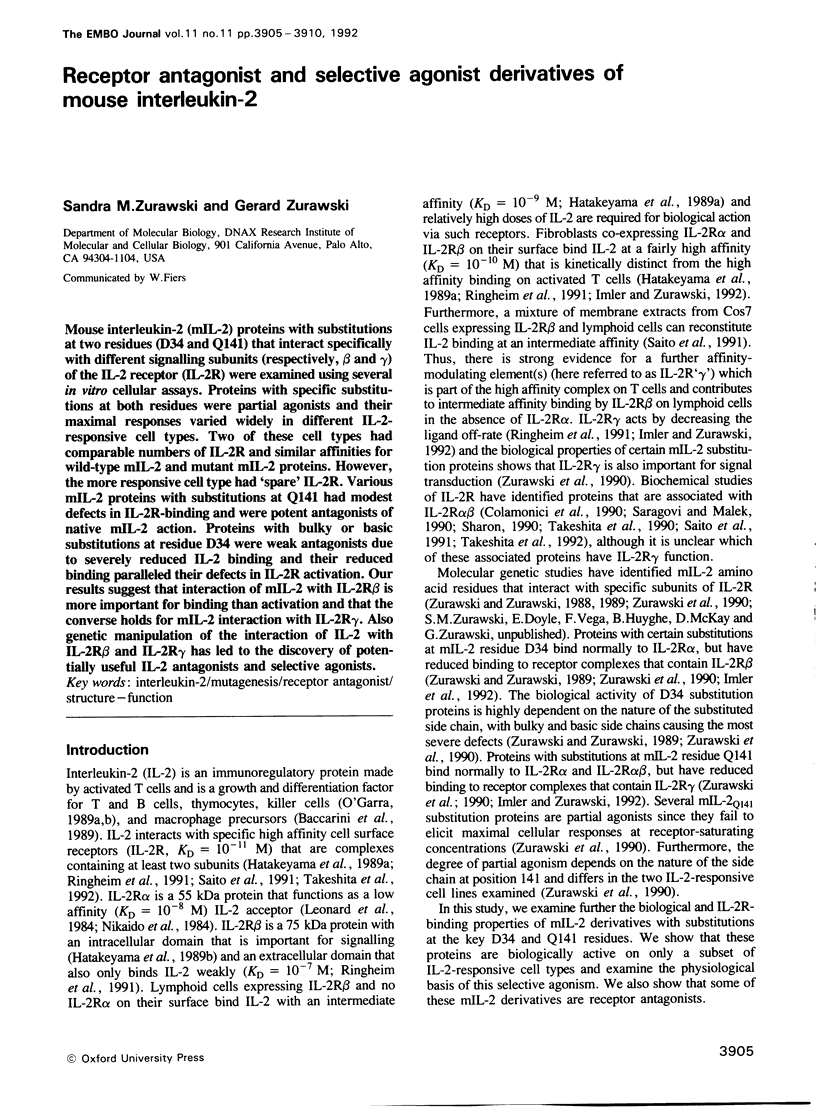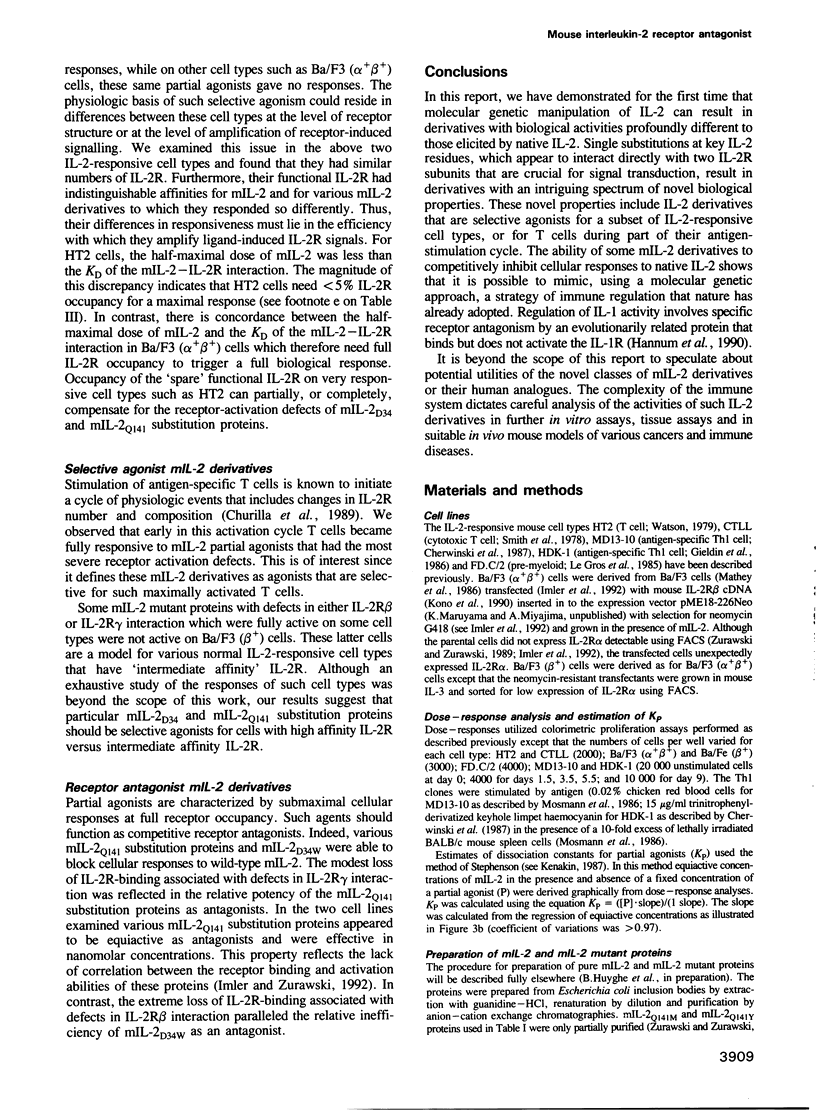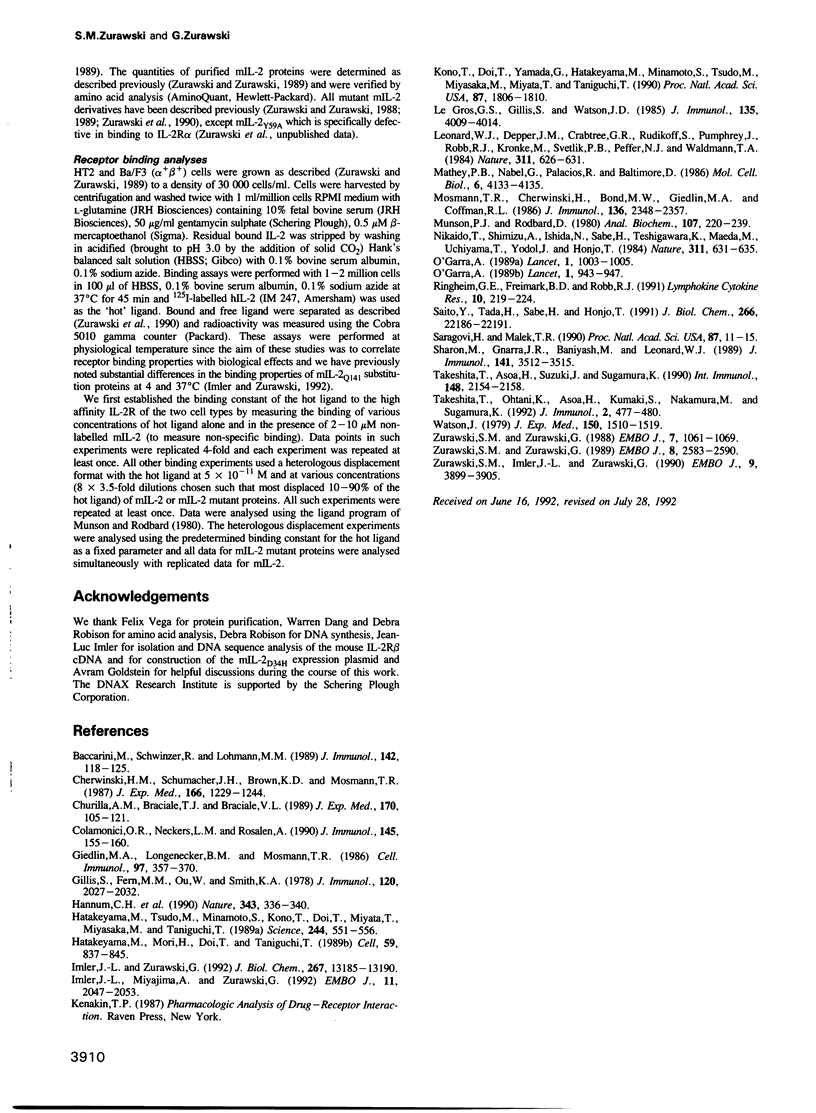Abstract
Mouse interleukin-2 (mIL-2) proteins with substitutions at two residues (D34 and Q141) that interact specifically with different signalling subunits (respectively, beta and gamma) of the IL-2 receptor (IL-2R) were examined using several in vitro cellular assays. Proteins with specific substitutions at both residues were partial agonists and their maximal responses varied widely in different IL-2-responsive cell types. Two of these cell types had comparable numbers of IL-2R and similar affinities for wild-type mIL-2 and mutant mIL-2 proteins. However, the more responsive cell type had 'spare' IL-2R. Various mIL-2 proteins with substitutions at Q141 had modest defects in IL-2R-binding and were potent antagonists of native mIL-2 action. Proteins with bulky or basic substitutions at residue D34 were weak antagonists due to severely reduced IL-2 binding and their reduced binding paralleled their defects in IL-2R activation. Our results suggest that interaction of mIL-2 with IL-2R beta is more important for binding than activation and that the converse holds for mIL-2 interaction with IL-2R gamma. Also genetic manipulation of the interaction of IL-2 with IL-2R beta and IL-2R gamma has led to the discovery of potentially useful IL-2 antagonists and selective agonists.
Full text
PDF





Selected References
These references are in PubMed. This may not be the complete list of references from this article.
- Baccarini M., Schwinzer R., Lohmann-Matthes M. L. Effect of human recombinant IL-2 on murine macrophage precursors. Involvement of a receptor distinct from the p55 (Tac) protein. J Immunol. 1989 Jan 1;142(1):118–125. [PubMed] [Google Scholar]
- Cherwinski H. M., Schumacher J. H., Brown K. D., Mosmann T. R. Two types of mouse helper T cell clone. III. Further differences in lymphokine synthesis between Th1 and Th2 clones revealed by RNA hybridization, functionally monospecific bioassays, and monoclonal antibodies. J Exp Med. 1987 Nov 1;166(5):1229–1244. doi: 10.1084/jem.166.5.1229. [DOI] [PMC free article] [PubMed] [Google Scholar]
- Churilla A. M., Braciale T. J., Braciale V. L. Regulation of T lymphocyte proliferation. Interleukin 2-mediated induction of c-myb gene expression is dependent on T lymphocyte activation state. J Exp Med. 1989 Jul 1;170(1):105–121. doi: 10.1084/jem.170.1.105. [DOI] [PMC free article] [PubMed] [Google Scholar]
- Colamonici O. R., Neckers L. M., Rosolen A. Putative gamma-subunit of the IL-2 receptor is detected in low, intermediate, and high affinity IL-2 receptor-bearing cells. J Immunol. 1990 Jul 1;145(1):155–160. [PubMed] [Google Scholar]
- Giedlin M. A., Longenecker B. M., Mosmann T. R. Murine T-cell clones specific for chicken erythrocyte alloantigens. Cell Immunol. 1986 Feb;97(2):357–370. doi: 10.1016/0008-8749(86)90406-5. [DOI] [PubMed] [Google Scholar]
- Gillis S., Ferm M. M., Ou W., Smith K. A. T cell growth factor: parameters of production and a quantitative microassay for activity. J Immunol. 1978 Jun;120(6):2027–2032. [PubMed] [Google Scholar]
- Hannum C. H., Wilcox C. J., Arend W. P., Joslin F. G., Dripps D. J., Heimdal P. L., Armes L. G., Sommer A., Eisenberg S. P., Thompson R. C. Interleukin-1 receptor antagonist activity of a human interleukin-1 inhibitor. Nature. 1990 Jan 25;343(6256):336–340. doi: 10.1038/343336a0. [DOI] [PubMed] [Google Scholar]
- Hatakeyama M., Mori H., Doi T., Taniguchi T. A restricted cytoplasmic region of IL-2 receptor beta chain is essential for growth signal transduction but not for ligand binding and internalization. Cell. 1989 Dec 1;59(5):837–845. doi: 10.1016/0092-8674(89)90607-7. [DOI] [PubMed] [Google Scholar]
- Hatakeyama M., Tsudo M., Minamoto S., Kono T., Doi T., Miyata T., Miyasaka M., Taniguchi T. Interleukin-2 receptor beta chain gene: generation of three receptor forms by cloned human alpha and beta chain cDNA's. Science. 1989 May 5;244(4904):551–556. doi: 10.1126/science.2785715. [DOI] [PubMed] [Google Scholar]
- Imler J. L., Miyajima A., Zurawski G. Identification of three adjacent amino acids of interleukin-2 receptor beta chain which control the affinity and the specificity of the interaction with interleukin-2. EMBO J. 1992 Jun;11(6):2047–2053. doi: 10.1002/j.1460-2075.1992.tb05262.x. [DOI] [PMC free article] [PubMed] [Google Scholar]
- Imler J. L., Zurawski G. Receptor binding and internalization of mouse interleukin-2 derivatives that are partial agonists. J Biol Chem. 1992 Jul 5;267(19):13185–13190. [PubMed] [Google Scholar]
- Kono T., Doi T., Yamada G., Hatakeyama M., Minamoto S., Tsudo M., Miyasaka M., Miyata T., Taniguchi T. Murine interleukin 2 receptor beta chain: dysregulated gene expression in lymphoma line EL-4 caused by a promoter insertion. Proc Natl Acad Sci U S A. 1990 Mar;87(5):1806–1810. doi: 10.1073/pnas.87.5.1806. [DOI] [PMC free article] [PubMed] [Google Scholar]
- Le Gros G. S., Gillis S., Watson J. D. Induction of IL 2 responsiveness in a murine IL 3-dependent cell line. J Immunol. 1985 Dec;135(6):4009–4014. [PubMed] [Google Scholar]
- Leonard W. J., Depper J. M., Crabtree G. R., Rudikoff S., Pumphrey J., Robb R. J., Krönke M., Svetlik P. B., Peffer N. J., Waldmann T. A. Molecular cloning and expression of cDNAs for the human interleukin-2 receptor. Nature. 1984 Oct 18;311(5987):626–631. doi: 10.1038/311626a0. [DOI] [PubMed] [Google Scholar]
- Mathey-Prevot B., Nabel G., Palacios R., Baltimore D. Abelson virus abrogation of interleukin-3 dependence in a lymphoid cell line. Mol Cell Biol. 1986 Nov;6(11):4133–4135. doi: 10.1128/mcb.6.11.4133. [DOI] [PMC free article] [PubMed] [Google Scholar]
- Mosmann T. R., Cherwinski H., Bond M. W., Giedlin M. A., Coffman R. L. Two types of murine helper T cell clone. I. Definition according to profiles of lymphokine activities and secreted proteins. J Immunol. 1986 Apr 1;136(7):2348–2357. [PubMed] [Google Scholar]
- Munson P. J., Rodbard D. Ligand: a versatile computerized approach for characterization of ligand-binding systems. Anal Biochem. 1980 Sep 1;107(1):220–239. doi: 10.1016/0003-2697(80)90515-1. [DOI] [PubMed] [Google Scholar]
- Nikaido T., Shimizu A., Ishida N., Sabe H., Teshigawara K., Maeda M., Uchiyama T., Yodoi J., Honjo T. Molecular cloning of cDNA encoding human interleukin-2 receptor. Nature. 1984 Oct 18;311(5987):631–635. doi: 10.1038/311631a0. [DOI] [PubMed] [Google Scholar]
- O'Garra A. Interleukins and the immune system 1. Lancet. 1989 Apr 29;1(8644):943–947. [PubMed] [Google Scholar]
- O'Garra A. Interleukins and the immune system 2. Lancet. 1989 May 6;1(8645):1003–1005. doi: 10.1016/s0140-6736(89)92640-8. [DOI] [PubMed] [Google Scholar]
- Ringheim G. E., Freimark B. D., Robb R. J. Quantitative characterization of the intrinsic ligand-binding affinity of the interleukin 2 receptor beta chain and its modulation by the alpha chain and a second affinity-modulating element. Lymphokine Cytokine Res. 1991 Jun;10(3):219–224. [PubMed] [Google Scholar]
- Saito Y., Tada H., Sabe H., Honjo T. Biochemical evidence for a third chain of the interleukin-2 receptor. J Biol Chem. 1991 Nov 25;266(33):22186–22191. [PubMed] [Google Scholar]
- Saragovi H., Malek T. R. Evidence for additional subunits associated to the mouse interleukin 2 receptor p55/p75 complex. Proc Natl Acad Sci U S A. 1990 Jan;87(1):11–15. doi: 10.1073/pnas.87.1.11. [DOI] [PMC free article] [PubMed] [Google Scholar]
- Sharon M., Gnarra J. R., Baniyash M., Leonard W. J. Possible association between IL-2 receptors and class I HLA molecules on T cells. J Immunol. 1988 Nov 15;141(10):3512–3515. [PubMed] [Google Scholar]
- Takeshita T., Ohtani K., Asao H., Kumaki S., Nakamura M., Sugamura K. An associated molecule, p64, with IL-2 receptor beta chain. Its possible involvement in the formation of the functional intermediate-affinity IL-2 receptor complex. J Immunol. 1992 Apr 1;148(7):2154–2158. [PubMed] [Google Scholar]
- Watson J. Continuous proliferation of murine antigen-specific helper T lymphocytes in culture. J Exp Med. 1979 Dec 1;150(6):1510–1519. doi: 10.1084/jem.150.6.1510. [DOI] [PMC free article] [PubMed] [Google Scholar]
- Zurawski S. M., Imler J. L., Zurawski G. Partial agonist/antagonist mouse interleukin-2 proteins indicate that a third component of the receptor complex functions in signal transduction. EMBO J. 1990 Dec;9(12):3899–3905. doi: 10.1002/j.1460-2075.1990.tb07610.x. [DOI] [PMC free article] [PubMed] [Google Scholar]
- Zurawski S. M., Zurawski G. Identification of three critical regions within mouse interleukin 2 by fine structural deletion analysis. EMBO J. 1988 Apr;7(4):1061–1069. doi: 10.1002/j.1460-2075.1988.tb02914.x. [DOI] [PMC free article] [PubMed] [Google Scholar]
- Zurawski S. M., Zurawski G. Mouse interleukin-2 structure-function studies: substitutions in the first alpha-helix can specifically inactivate p70 receptor binding and mutations in the fifth alpha-helix can specifically inactivate p55 receptor binding. EMBO J. 1989 Sep;8(9):2583–2590. doi: 10.1002/j.1460-2075.1989.tb08397.x. [DOI] [PMC free article] [PubMed] [Google Scholar]


